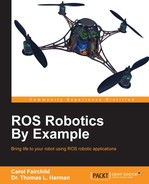If you are communicating with ROS via the terminal window, it is possible to issue commands to ROS to explore or control nodes in a package from the command prompt, as listed in the following table:
The website (http://wiki.ros.org/ROS/CommandLineTools) describes many ROS commands. The table lists some important ones. However, these examples only cover a few of the possible variations of the commands.
..................Content has been hidden....................
You can't read the all page of ebook, please click here login for view all page.
